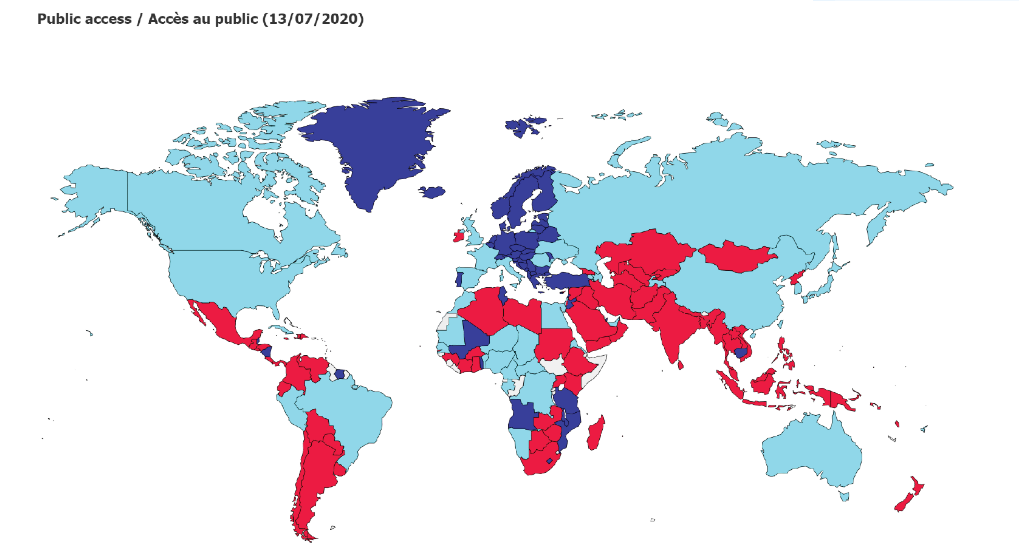![]() In the wake of the Covid-19 pandemic, many governments have taken measures to restrict movements of people and access to certain areas.
In the wake of the Covid-19 pandemic, many governments have taken measures to restrict movements of people and access to certain areas.
Introduction to the global map on the closure of World Heritage sites due to Covid-19 and analysis: this includes the closure of natural and cultural World Heritage sites in the 167 countries they are located in. Please consider the following when reviewing the map:
The World Heritage Convention has been ratified by 193 States Parties but only 167 countries have properties on UNESCO’s World Heritage List;
The List includes a total of 1,121 natural, cultural and mixed World Heritage sites;
In some countries with federal systems there may be a different approach for certain areas within the country;
For some types of sites such as city centres, urban ensembles or agricultural landscapes access may be still possible to certain public areas of the sites, while other parts of the site may be closed, including site museums, visitor centres, religious or emblematic buildings;
For some countries, sites are being re-opened, such as in China;
While sites are closed, monitoring activities by site management may continue, especially for natural sites, including by anti-poaching units, monitoring by satellite images or drones and emergency interventions, for example in case of fires.
Analysis
The map displaying the 167 States Parties with World Heritage properties show that 72 (= 43%) countries have closed sites totally, whereas 54 (= 33%) countries kept their sites open. For 41 countries (24%) partial closure has been indicated, which includes countries that are re-opening World Heritage places slowly after the crisis.
The information on the map, based on the major trends observed at the national levels, will be further updated on a weekly basis, as new data comes in.
Fonte: UNESCO.org
![]() Sulla scia della pandemia di Covid-19, molti governi hanno adottato misure per limitare i movimenti di persone e l’accesso ad alcune aree.
Sulla scia della pandemia di Covid-19, molti governi hanno adottato misure per limitare i movimenti di persone e l’accesso ad alcune aree.
UNESCO sta quindi monitorando la chiusura dei siti del patrimonio mondiale a causa di Covid-19 e ne propone una mappa e relativa analisi, che include la chiusura dei siti del patrimonio mondiale naturale e culturale nei 167 paesi in cui si trovano.
Per la revisione della mappa, tenere presente quanto segue:
La Convenzione del Patrimonio Mondiale è stata ratificata da 193 Stati Parte, ma solo 167 Paesi hanno proprietà nella Lista del Patrimonio Mondiale dell’UNESCO;
L’elenco comprende un totale di 1.121 siti Patrimonio dell’Umanità naturali, culturali e misti;
In alcuni paesi con sistemi federali potrebbe esserci un approccio diverso per alcune aree all’interno del paese;
Per alcuni tipi di siti come centri urbani, complessi urbani o paesaggi agricoli l’accesso potrebbe essere ancora possibile ad alcune aree pubbliche dei siti, mentre altre parti del sito potrebbero essere chiuse, tra cui musei del sito, centri visitatori, edifici religiosi o emblematici;
Per alcuni paesi, i siti vengono riaperti, come in Cina;
Mentre i siti sono chiusi, le attività di monitoraggio da parte della direzione del sito possono continuare, in particolare per i siti naturali, anche mediante unità anti-bracconaggio, monitoraggio tramite immagini satellitari o droni e interventi di emergenza, ad esempio in caso di incendi.
Analisi
La mappa che mostra i 167 Stati Parte con proprietà Patrimonio dell’Umanità mostra che 72 (= 43%) paesi hanno completamente chiuso i siti, mentre 54 (= 33%) hanno mantenuto i loro siti aperti. Per 41 paesi (24%) è stata indicata la chiusura parziale, che comprende paesi che stanno riaprendo lentamente i luoghi del Patrimonio Mondiale dopo la crisi.
Le informazioni sulla mappa, basate sulle principali tendenze osservate a livello nazionale, saranno ulteriormente aggiornate su base settimanale, man mano che arrivano nuovi dati.

